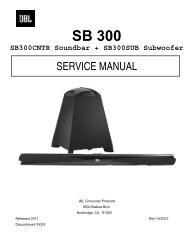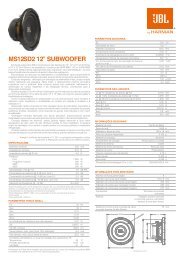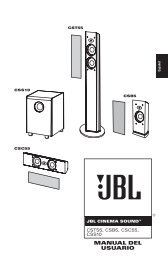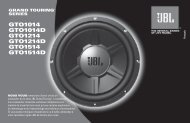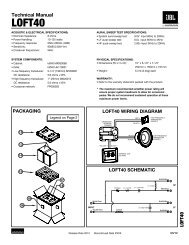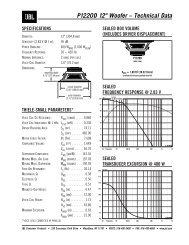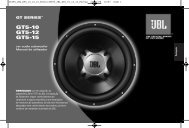You also want an ePaper? Increase the reach of your titles
YUMPU automatically turns print PDFs into web optimized ePapers that Google loves.
DESIGNING A SPEAKER SYSTEM FOR THE GTi AMPLIFIER<br />
NOTE: Although the <strong>JBL</strong> A6000GTi or<br />
A3000GTi amplifier will drive a system<br />
made up of any subwoofers, we<br />
re<strong>com</strong>mend using <strong>JBL</strong> GTi subwoofers<br />
with GTi amplifiers.<br />
Both the <strong>JBL</strong> A6000GTi and A3000GTi<br />
amplifiers provide RMS power that<br />
exceeds the RMS power-handling<br />
rating of nearly every subwoofer<br />
available. To use this amplifier<br />
optimally, you should design a speaker<br />
system made up of several identical<br />
speakers, so that the power delivered<br />
by the amplifier will be shared equally<br />
among the speakers.<br />
The <strong>JBL</strong> A6000GTi and A3000GTi<br />
amplifiers support a wide range of<br />
impedances, and any speaker system<br />
with a total or equivalent impedance of<br />
1 to 4 ohms will extract full power from<br />
either amplifier. In order to connect<br />
multiple woofers to the A6000GTi or<br />
A3000GTi, you’ll need to connect your<br />
speakers in series, parallel or seriesparallel.<br />
We’ve included diagrams for<br />
each connection scheme and a pair of<br />
formulas, which will help you.<br />
SERIES CONNECTIONS<br />
The formula for determining the<br />
total impedance of the two woofers<br />
connected in series is:<br />
Z total = Z 1 + Z 2 + Z 3 ...<br />
Where Z total is the total impedance of<br />
all woofers connected in series. Z 1 , Z 2<br />
and Z 3 (and so on) are the nominal<br />
impedance ratings of the individual<br />
speakers. The total impedance of the<br />
voice coils shown in Figure 2 is 8 ohms.<br />
4 ohms 4 ohms<br />
PARALLEL<br />
CONNECTIONS<br />
The formula for determining the<br />
equivalent impedance of the voice<br />
coils connected in parallel is:<br />
Z equivalent = 1/(1/Z 1 + 1/Z 2 + 1/Z 3 …)<br />
Where Z equivalent is the equivalent<br />
impedance of the coils connected in<br />
parallel. Z 1 , Z 2 and Z 3 (and so on) are<br />
the nominal impedance ratings of the<br />
individual speakers. The equivalent<br />
impedance of the voice coils shown in<br />
Figure 3 is 2 ohms.<br />
4 ohms 4 ohms<br />
Figure 3. Parallel connection of two<br />
4-ohm voice coils yields a total<br />
impedance of 2 ohms.<br />
DUAL VOICE-COIL<br />
CONNECTIONS<br />
Dual voice-coil subwoofers, such as<br />
<strong>JBL</strong>’s GTi series, may be connected<br />
in series, as shown in Figure 2; in<br />
parallel, as shown in Figure 3; or in<br />
series-parallel, as shown in Figure 4.<br />
Figure 4. Series-parallel connections<br />
of three W15GTi subwoofers (with a<br />
voice coil impedance of 6 ohms) yields<br />
a total series impedance of 12 ohms<br />
for each subwoofer, and an equivalent<br />
parallel impedance of 4 ohms for all<br />
three subwoofers.<br />
To determine the impedance of a<br />
system of three W15GTi (dual voicecoil)<br />
subwoofers connected in seriesparallel,<br />
use the series connection<br />
formula to determine the impedance<br />
of each subwoofer with its voice coils<br />
connected in series. Then insert the<br />
calculated value into the parallel<br />
connection formula to determine the<br />
equivalent impedance for the three<br />
subwoofers connected in parallel.<br />
NOTE: Each W15GTi voice coil has an<br />
impedance of 6 ohms.<br />
For example, in Figure 4, each woofer<br />
will have an impedance of 12 ohms, by<br />
Z total = Z 1 + Z 2 = 6 + 6 = 12<br />
and the three woofers connected<br />
in parallel will have an equivalent<br />
impedance of 4 ohms, by<br />
Z equivalent = 1/(1/Z 1 + 1/Z 2 + 1/Z 3 )<br />
= 1/(1/12 + 1/12 + 1/12)<br />
= 1/(3/12)<br />
= 12/3 = 4<br />
NOTE: All subwoofers connected to an<br />
amplifier in a system must be identical<br />
and, if they are dual voice-coil subwoofers,<br />
their coils must be wired<br />
identically. Do not connect the coils of<br />
one subwoofer together in series and<br />
another in parallel, since doing so will<br />
cause uneven power distribution,<br />
potential damage to the speakers, and<br />
poor overall performance.<br />
Remove<br />
Terminal Jumper<br />
ABOUT SPEAKER<br />
POWER HANDLING<br />
The RMS power handling rating of<br />
a speaker indicates the amount of<br />
power it will handle continuously.<br />
Although designing a subwoofer<br />
system by considering the RMS rating<br />
will ultimately provide you with the<br />
most reliable system, your speakers<br />
may be able to handle more power,<br />
depending on what kind of music is<br />
being reproduced.<br />
For music with extended bass notes<br />
(e.g., bass music, hip-hop or techno),<br />
you should design a speaker system<br />
based on the RMS power handling of<br />
your speakers. For music with sharp<br />
transient bass notes (e.g., rock,<br />
country or jazz), the RMS power<br />
handling rating is conservative, and<br />
you can count on your speakers being<br />
able to handle more power than the<br />
RMS rating.<br />
The total power output of your<br />
amplifier will be divided among the<br />
speakers connected to it. For example,<br />
if you are using an A6000GTi and three<br />
W15GTi subwoofers, each subwoofer<br />
will receive 2,000 watts.<br />
It’s important to choose a system of<br />
subwoofers that will handle all of the<br />
power. To determine how much total<br />
power your speaker system will<br />
handle, simply multiply the RMS power<br />
handling rating of one of your speakers<br />
by the total number of speakers that<br />
will be connected.<br />
Red<br />
Figure 2. Series connection of two<br />
4-ohm voice coils yields a total<br />
impedance of 8 ohms.<br />
Black<br />
Remove<br />
Terminal Jumper<br />
3




